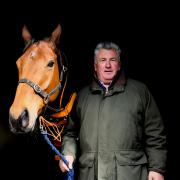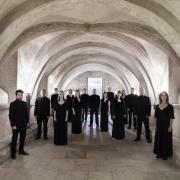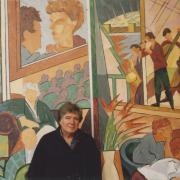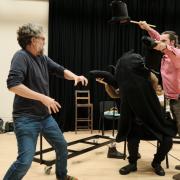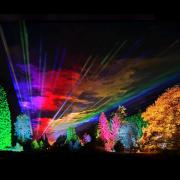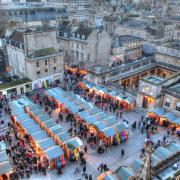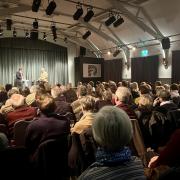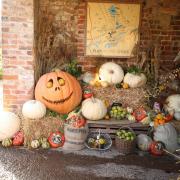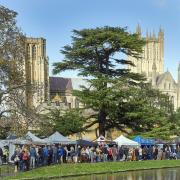From Dixon of Dock Green to Downton Abbey, Charmian Adams creates the onscreen worlds loved by millions of film fans and TV viewers the world over

Charmian Adams answers her mobile. It's windy, there's muffled noise, people's voices, a commotion going on in the background. "Can you hold on a minute? I'll go somewhere quieter," she hurriedly explains…
It turns out she's on an industrial site somewhere in Wales. She's on set filming a new TV version of War of the Worlds.
"We've had endless discussions about aliens - even the feet," she tells me several weeks later when we finally meet.
Charmian lives in a beautiful, old stone house in Compton Dundon. Renovating the building was a labour of love, taking many years. It took weeks to scrape the concrete off the precious flagstone floors, a gruelling task that many would give up on - but Charmian is used to this kind of diligent, detailed work.
She's an art director, working on film and television productions. The role involves working closely with the production designer and director, to create their vision for the film - everything you see on screen, apart from the costumes worn by the actors.
Her work is extremely varied, she could be measuring a room in a London flat inch by inch so it can be recreated in another country; or arguing in French over how many wheelbarrows of mud are needed for a scene. And she can be working anywhere in the world at the drop of a hat.
It's a chaotic life.
Born in 1943, Charmian had a difficult childhood, but quickly took her future into her own hands. Initially thinking about architecture, she ended up doing fine art at Brighton College of Art and Crafts.
"I always drew, I've always drawn," she says.

After seeing his productions in the West End, she wrote to famed theatre designer Sean Kenny.
"I said, 'Can I come and work for you?' He wrote back and said, 'Get that bit of paper in your hand'."
She also wrote to the BBC and was immediately offered a job in the art department - despite not having yet taken her exams.
It was 1964 and she found herself on the set of Dixon of Dock Green.
"I went into a studio for the first time in my life and it was all painted in colours!" she recalls her reaction, as at the time television was in black and white.
She found leaving college and adapting to the work difficult.
"For the first couple of days you realise you know absolutely nothing." On top of that was the unwanted attentions of some male members of staff. She remembers being 'hugged' a little too closely. It was the culture at the time, she says, but she hated it, and wanted to leave.
But she stayed, partly because she slipped into the Top of the Pops set and started asking how things were done. The person she asked was Martin Johnson - the production designer who became her husband.
"I was protected then," she says wryly.
And there were the amazing moments, like when she shared a lift with the ballet dancer Margot Fonteyn, who bent her tutu down to make room for Charmian. "I couldn't believe I was in such proximity to her - me...a girl from Worthing!"
Charmian's career took a halt when she had her children. She kept herself busy with an Open University degree in Soviet politics and economics, (she had 'big holes' in her education she says) but she continued to draw and always had the connection with work through Martin, doing odd bits like making set models, and there was the constant talk about work at home, which kept her in the loop.
The couple initially lived in East Anglia, but moved to Somerset after discovering the county through their friend, the film director Ken Loach, who had moved to Bath.
It was a former colleague, Sally Hulke, who was then working at BBC Bristol, who set Charmian back on the road to employment.
"Sally retrained me, most people would say forget it. She was an amazing boss, she never closed her door. I owe my career to her."
Filling in with "the jobs no-one else wanted to do," Charmian rebuilt her career.
In the mid 80s she was employed as assistant art director on the film Sid and Nancy. The work included designing a complicated curved set of steps for a famous scene in which Gary Oldman, as punk icon Sid Vicious sings My Way on stage.
It was filmed in a cinema off Leicester Square and there was a busy road outside. Charmian couldn't concentrate enough to draw a plan for the technical challenge posed by the stairway. "In the end I got in my car and drove back here, (Somerset) to do it in the quiet," she recalls.
A couple of years later: "I'd become art director on a feature film with Tommy Lee Jones and Sting - Stormy Monday. I was jolly lucky."
Her list of credits is phenomenal and includes Downton Abbey, Cranford, Jonathan Strange & Mr Norrell, McMafia and last year's BBC production of Les Miserables.
She says it took a year of planning for McMafia and then most of the filming took place in Croatia. But on one occasion a white van, used in a scene where young girls are kidnapped to be taken into slavery, had to be flown to Egypt for a few seconds of footage, as there was no similar van to be found in Cairo.
She says she became obsessed with Les Miserables. After buying a translation of the French classic in the bookshop at Castle Cary, she went through the text, marking it up, and highlighting details - everything that caught her creative eye, from the building shaped like an elephant where the Parisian orphans lived, to what the characters ate.
Sadly, the elephant never made it to screen. "We tried so hard to hang on to the elephant, but it had to go in the end," she sighs.
They built the Parisian sewers, with the special effects department making a liquid 'sewage' that would be ok if the actors accidentally swallowed it; and then there were the rats, brought in by the rat handler, which were strictly 'not allowed' in the water.
Filming took place in Belgium and Paris but many props had to be brought in from England, including fully grown hedges which were needed for garden scenes.
"We have an amazing props industry in England," she says, adding that the hedges were all returned home safely.
The famous barricade scenes involved covering shop fronts and street signs, and: "We had to make a building to cover a car park.
"We had rubber chairs made so they could throw them over and over again."
But authenticity is paramount throughout, every 'fake' prop being lovingly made and many were genuine antiques, like the carriage which gets pulled onto its side in the riots. Its glass windows were removed beforehand to prevent too much damage.
"I can't stress enough how much it is a team thing," says Charmian, reflecting on her work.
"It's a weird job. I'll be in the middle of some ghastly place, dripping wet and I'll think, why am I doing this?
"But it's taken me to places I'd never get to. And you end up in places with people you'd not normally meet and it's such a bonus - I'm so lucky."
"It allows you to be a completely nosey parker," she laughs.



